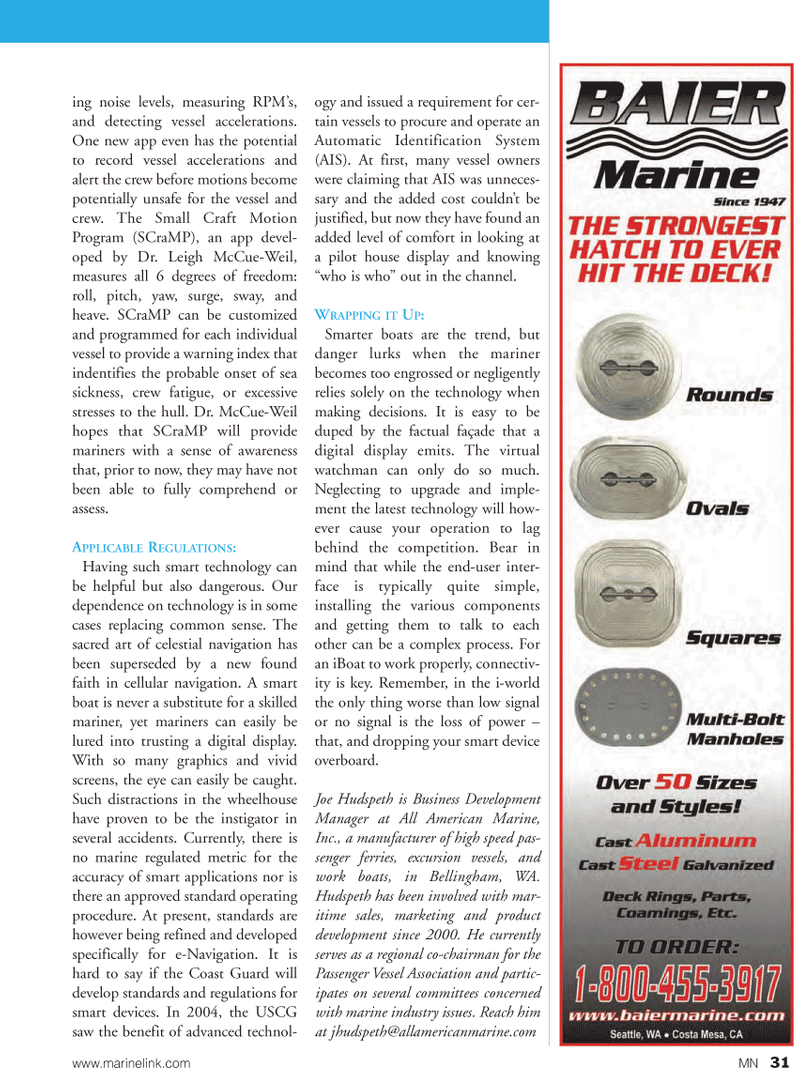
Page 31: of Marine News Magazine (June 2012)
Dredging & Marine Construction
Read this page in Pdf, Flash or Html5 edition of June 2012 Marine News Magazine
ing noise levels, measuring RPMs, and detecting vessel accelerations. One new app even has the potential to record vessel accelerations and alert the crew before motions become potentially unsafe for the vessel and crew. The Small Craft Motion Program (SCraMP), an app devel- oped by Dr. Leigh McCue-Weil, measures all 6 degrees of freedom: roll, pitch, yaw, surge, sway, and heave. SCraMP can be customized and programmed for each individual vessel to provide a warning index that indentifies the probable onset of sea sickness, crew fatigue, or excessive stresses to the hull. Dr. McCue-Weil hopes that SCraMP will provide mariners with a sense of awareness that, prior to now, they may have not been able to fully comprehend or assess.APPLICABLEREGULATIONS :Having such smart technology can be helpful but also dangerous. Our dependence on technology is in somecases replacing common sense. The sacred art of celestial navigation has been superseded by a new found faith in cellular navigation. A smart boat is never a substitute for a skilled mariner, yet mariners can easily be lured into trusting a digital display. With so many graphics and vivid screens, the eye can easily be caught. Such distractions in the wheelhouse have proven to be the instigator in several accidents. Currently, there is no marine regulated metric for the accuracy of smart applications nor is there an approved standard operating procedure. At present, standards are however being refined and developed specifically for e-Navigation. It is hard to say if the Coast Guard will develop standards and regulations for smart devices. In 2004, the USCG saw the benefit of advanced technol- ogy and issued a requirement for cer- tain vessels to procure and operate an Automatic Identification System (AIS). At first, many vessel owners were claiming that AIS was unneces- sary and the added cost couldnt be justified, but now they have found an added level of comfort in looking at a pilot house display and knowing who is who? out in the channel. WRAPPINGIT UP:Smarter boats are the trend, but danger lurks when the marinerbecomes too engrossed or negligently relies solely on the technology when making decisions. It is easy to be duped by the factual façade that a digital display emits. The virtual watchman can only do so much.Neglecting to upgrade and imple- ment the latest technology will how- ever cause your operation to lag behind the competition. Bear in mind that while the end-user inter-face is typically quite simple,installing the various components and getting them to talk to eachother can be a complex process. For an iBoat to work properly, connectiv- ity is key. Remember, in the i-world the only thing worse than low signal or no signal is the loss of power ? that, and dropping your smart device overboard. Joe Hudspeth is Business Development Manager at All American Marine, Inc., a manufacturer of high speed pas- senger ferries, excursion vessels, and work boats, in Bellingham, WA. Hudspeth has been involved with mar- itime sales, marketing and product development since 2000. He currently serves as a regional co-chairman for the Passenger Vessel Association and partic- ipates on several committees concerned with marine industry issues. Reach him at [email protected] MN31

 30
30

 32
32
